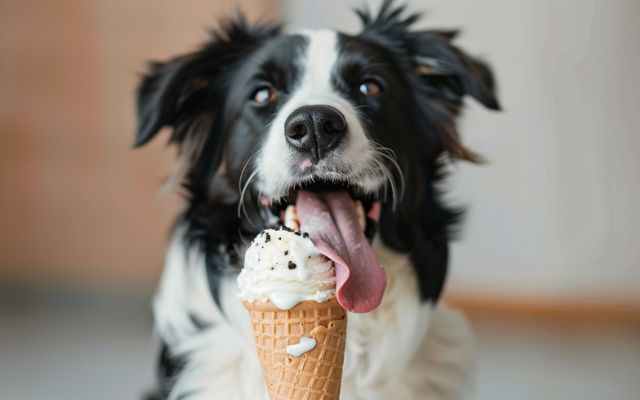Have you ever noticed those inky spots dotting your dog’s tongue? It’s like they’ve been snacking on squid ink! But don’t worry, these “tongue tattoos” are usually nothing to fret about. They’re simply a natural quirk, like freckles on a human. In this guide, we’ll unravel the mystery behind black spots on dog tongues. We’ll delve into the science, explore breed-specific tendencies, and equip you with the knowledge to tell when those spots are normal or warrant a vet visit.
So, if you’re ready to become a dog tongue expert, read on! We’ll help you decode this intriguing canine characteristic and put your mind at ease.
The Science of Spots: What Causes Black Pigmentation?
Think of melanin as your dog’s personal paint set. This pigment not only gives their fur and skin its unique color but also creates those intriguing spots on their tongue.
Melanin: The Master Artist
Melanin is a powerful pigment produced by specialized cells called melanocytes. It comes in different shades, like black-brown eumelanin and reddish-yellow pheomelanin. These pigments combine to create the diverse range of coat colors and patterns we see in dogs.
But melanin is more than just a pretty face. It also acts as a natural sunscreen, protecting your dog’s delicate skin and even their tongue from the sun’s harmful rays. So, those black spots might just be your pup’s way of staying sun-safe!

Genetics: The Blueprint for Spots
Just like you might inherit your mom’s curly hair or your dad’s eye color, your dog’s tongue spots are often a gift from their ancestors. Certain breeds, like Chow Chows and Shar-Peis, are known for their solid black tongues, while others sport spots thanks to the fascinating dance of genetics.
In fact, over 30 breeds are prone to developing black spots on their tongues, and even mixed breeds can inherit this trait from their diverse lineage. It’s all part of the intricate genetic code that makes each dog unique.
Age and Hormones: The Shifting Colors
As dogs age, their pigment can change, just like our hair might gray. Existing spots might darken or new ones could appear. This is a normal part of aging, like wrinkles or a distinguished white muzzle.
Hormonal shifts, such as those that occur during pregnancy or due to certain medications, can also influence pigmentation. These changes are usually subtle and harmless, but it’s always worth mentioning them to your vet during regular checkups.
Normal vs. Not-So-Normal: Decoding Your Dog’s Tongue Spots
Think of your dog’s tongue as a unique canvas, painted with spots of various shapes and sizes. But how can you tell if these spots are just artistic flair or a potential health concern? Let’s break it down.
Perfectly Normal Spots: A Gallery of Variation
Normal tongue spots come in various shapes and sizes. Some dogs might have a single, tiny dot, while others boast a whole constellation of larger patches. The color can also vary, ranging from a deep blue-black to a lighter shade of black.
These normal spots share a few key characteristics:
- Flat: They should feel the same as the rest of the tongue’s surface, not raised or lumpy.
- Smooth: The texture should be consistent with the surrounding tongue tissue.
- Color: The shade of black might vary, but it shouldn’t be red, purple, or any other unusual color.
- Unchanging: Normal spots might slowly change over time, but they shouldn’t morph rapidly or become significantly larger or smaller.

Red Flags: When to Worry
While most black spots are harmless, there are a few red flags that warrant a trip to the vet:
- Raised or Lumpy Spots: If a spot feels raised or bumpy, it could be a growth that needs further examination.
- Ulcerated or Bleeding Spots: Any sore or bleeding spot on the tongue should be checked out by a veterinarian.
- Oddly Colored Spots: If you notice red, purple, or any other unusual color, it’s time to seek professional advice.
- Rapid Changes: If a spot changes size, shape, or color quickly, it’s important to have it evaluated.
- Bad Breath or Difficulty Eating: These symptoms could indicate an underlying health issue and should be investigated by a vet.
When in Doubt, Check It Out
Remember, when it comes to your dog’s health, it’s always better to be safe than sorry. If you notice any of the red flags mentioned above, or if you’re simply unsure about a spot, don’t hesitate to schedule a visit with your veterinarian.
They can examine your dog’s tongue, assess the situation, and provide peace of mind or recommend further testing if needed. Your vet’s expertise is invaluable in determining whether a spot is a harmless quirk or something that requires further attention.
Spot the Breed: Does Your Dog Belong to the Exclusive Tongue Tattoo Club?
Think your dog’s black tongue spots are a rare find? Think again! While Chow Chows and Shar-Peis are famous for their inky tongues, they’re just the tip of the iceberg in this stylish canine club.
Surprising Members: More Than Just Chows & Shar-Peis
Get ready for a tongue-twisting surprise! These popular breeds are known to rock black spots on their tongues:
- Golden Retrievers: America’s sweethearts, often with a few adorable freckles to match their sunny disposition.
- Labrador Retrievers: These playful water enthusiasts might surprise you with hidden treasures under their tongues.
- Poodles: Poodles are known for their elegance and intelligence, and some even sport a fashionable spotted tongue.
- German Shepherds: These loyal protectors might have a few secrets hiding beneath their tongues, adding to their mystique.
- Dalmatians: Famous for their spotted coats, it’s only fitting that some Dalmatians also have matching spots on their tongues.
- Airedale Terriers: These energetic adventurers often sport a few tongue freckles to complement their distinctive black and tan coats.
Mixed Breeds: A Genetic Treasure Hunt
If your furry friend is a mixed breed, their spotted tongue could be a clue to their hidden heritage. Any breed with a genetic predisposition for tongue spots might have passed down this unique trait to your pup.
Unraveling your dog’s ancestry through a DNA test could reveal surprising connections to breeds you never imagined. Your mixed breed might have a touch of Chow Chow, a dash of Shar-Pei, or a sprinkle of another spotted-tongue breed lurking in their genes!
Spots & Style: The Fashionable Fido
For some breeds, tongue spots aren’t just a random occurrence; they’re a fashion statement! Australian Shepherds with a mesmerizing merle coat pattern often have matching spots on their tongues, creating a coordinated look.
Similarly, some Dalmatians with a rich, liver-colored coat might have matching liver-colored spots on their tongues. It’s like they’re accessorizing!
So, next time you peek at your dog’s tongue, remember, those black spots are more than just a quirk. They’re a unique expression of their genetic heritage, a mark of distinction, and a reminder of the incredible diversity within the canine world.
MythBusters & FAQs: Tongue-Tied About Spots? We’ve Got You Covered
Black spots on dog tongues spark curiosity and sometimes a bit of worry. Let’s tackle some common myths and burning questions to put your mind at ease.
MythBusters: Debunking Tongue Spot Tall Tales
- Myth 1: Black Spots = Chow Chow Genes: While Chow Chows are known for their solid black tongues, many other breeds and mixed breeds sport spots too. It’s not a foolproof ancestry test!
- Myth 2: Food is to Blame: Unless your vet diagnoses a serious nutritional deficiency, your dog’s diet isn’t the cause of those spots. Melanin production is mainly genetic, like your own freckles.
- Myth 3: Ouch! Are Spots Painful? Not at all! Normal spots are simply pigment variations and don’t cause any discomfort for your pup.

FAQ Frenzy: Your Top Questions Answered
- Can I Erase Those Spots? Technically, yes, with laser treatments. But it’s usually unnecessary and purely cosmetic. Unless a spot causes problems, most vets say, “Let those spots shine!”
- Do Spots Mess with Taste? Nope! Your dog’s taste buds are safe and sound. Those spots won’t interfere with their ability to enjoy their favorite treats.
- Spots on Gums/Lips Too? If your dog has pigmented gums or lips, matching spots in those areas are perfectly normal. It’s just their unique pigmentation pattern expressing itself.
- Can Puppies Get Spots Later? Absolutely! Some pups are born with spots, while others develop them as they grow. It’s all part of their genetic blueprint unfolding.
- New Spot on My Senior Dog? Should I Panic? New growths or pigmentation changes in older dogs always warrant a vet check. It’s likely nothing, but better safe than sorry, right?
With these myths busted and questions answered, you’re well on your way to becoming a dog tongue expert! Remember, knowledge is power when it comes to your furry friend’s health.
Conclusion
There you have it! Those intriguing black spots on your dog’s tongue are usually just a harmless quirk, a unique signature in their genetic code. It’s like their tongue has a story to tell, a tale of ancestry and individuality.
You’ve now got the know-how to decipher those spots, differentiating between normal variations and potential red flags. Remember, when in doubt, your trusty veterinarian is just a phone call away. They’ll help you determine if those spots are simply a charming feature or something that needs a closer look.
So, the next time you catch a glimpse of those inky freckles on your dog’s tongue, you can smile, knowing they’re a harmless reminder of your furry friend’s uniqueness. It’s just another reason to love that slobbery smooch!

Healthy dogs mean happy dogs, and that makes me happy! I’m here to share all the tips for keeping your best furry friend in top shape, from puppyhood to their golden years.

